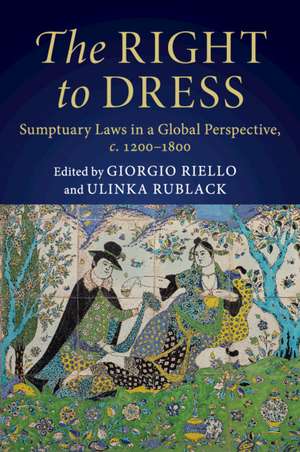The Right to Dress: Sumptuary Laws in a Global Perspective, c.1200–1800
Editat de Giorgio Riello, Ulinka Rublacken Limba Engleză Paperback – 12 feb 2020
| Toate formatele și edițiile | Preț | Express |
|---|---|---|
| Paperback (1) | 360.78 lei 6-8 săpt. | |
| Cambridge University Press – 12 feb 2020 | 360.78 lei 6-8 săpt. | |
| Hardback (1) | 875.35 lei 6-8 săpt. | |
| Cambridge University Press – 16 ian 2019 | 875.35 lei 6-8 săpt. |
Preț: 360.78 lei
Nou
Puncte Express: 541
Preț estimativ în valută:
69.05€ • 71.54$ • 57.62£
69.05€ • 71.54$ • 57.62£
Carte tipărită la comandă
Livrare economică 22 martie-05 aprilie
Preluare comenzi: 021 569.72.76
Specificații
ISBN-13: 9781108469272
ISBN-10: 1108469272
Pagini: 523
Dimensiuni: 153 x 230 x 30 mm
Greutate: 0.69 kg
Editura: Cambridge University Press
Colecția Cambridge University Press
Locul publicării:Cambridge, United Kingdom
ISBN-10: 1108469272
Pagini: 523
Dimensiuni: 153 x 230 x 30 mm
Greutate: 0.69 kg
Editura: Cambridge University Press
Colecția Cambridge University Press
Locul publicării:Cambridge, United Kingdom
Cuprins
List of illustrations; List of figures; List of maps; List of tables; List of contributors; Acknowledgements; The Right to Dress: The World of Sumptuary Laws, c.1200–1800 Ulinka Rublack and Giorgio Riello; Part I. Sumptuary Laws in Medieval and early modern Europe: 1. The right to dress: sartorial politics in Germany, c.1300–1750 Ulinka Rublack; 2. Playing by the rules? Dressing without sumptuary laws in the low countries from the fourteenth to the eighteenth century Isis Sturtewagen and Bruno Blondé; 3. 'Outlandish superfluities': luxury and clothing in Scottish and English sumptuary law, fourteenth to the seventeenth century Maria Hayward; 4. Regulating sumptuousness: changing configurations of morals, politics, and economics in Swiss cities in the seventeenth and eighteenth centuries André Holenstein; 5. Dangerous fashion in Swedish sumptuary law Eva I. Andersson; Part II. Enacting Sumptuary Laws in Italy: 6. Sumptuary laws in Italy financial resource and instrument of rule Maria Giuseppina Muzzarelli; 7. Defending the right to dress: two sumptuary law protests in sixteenth-century Milan Catherine Kovesi; 8. Against the sumptuary regime: sumptuary prosecutions in sixteenth- and seventeenth-century Padova Luca Molà and Giorgio Riello; Part III. The European Maritime Powers and their Empires: 9. Luxury, novelty, and nationality: sumptuary legislation in Late Medieval and Early Modern Spain Amanda Wunder; 10. Sumptuary laws in Portugal and its empire from the fourteenth to the eighteenth century Francisco Bethencourt; 11. 'Splendour and magnificence': diplomacy and sumptuary codes in Early Modern Batavia Adam Clulow; 12. Race, clothing and identity: sumptuary laws in colonial Spanish America Rebecca Earle; 13. Sartorial sorting in the colonial Caribbean and North America Robert DuPlessis; Part IV. Early Modern World Empires: 14. 'Grandeur and show': clothing, commerce, and the Capital in early modern Russia Matthew P. Romaniello; 15. Women, minorities, and the changing politics of dress in the Ottoman Empire, 1650–1830 Madeline Zilfi; 16. Wearing the hat of loyalty: imperial power and dress reform in Ming Dynasty China BuYun Chen; 17. Regulating excess: the cultural politics of consumption in Tokugawa Japan Katsuya Hirano; 18. Sumptuary laws in precolonial West Africa: the examples of Benin and Dahomey Toby Green; Select bibliography; Index.
Recenzii
'This brilliant and truly global collection of essays show how ingeniously and even courageously people used clothing to subvert systems of rank, from Paduan dandies arrested for the splendor of their dress to a Mohawk chieftain's self-display in a British frock coat.' Ann Rosalind Jones, Smith College, Massachusetts
'A fascinating view of how especially townspeople of some means received the orders of their superiors, conforming, stridently negotiating the details, or quietly ignoring the rules of dress. In the end, the authors remind us people's right to dress as they please is part of a utopia of liberty that today seems more remote than ever.' Suraiya Faroqhi, Ibn Haldun University, Turkey
'When did clothing become a crime? This collection of essays by leading experts shows how anxiety over expenditure and ownership is a long-standing global phenomena. Ranging across Europe and its colonies, and extending into the Chinese, Russian and Ottoman empires, this book brings to life the complexities of sumptuary laws and their application.' Evelyn Welch, King's College London
'A fascinating view of how especially townspeople of some means received the orders of their superiors, conforming, stridently negotiating the details, or quietly ignoring the rules of dress. In the end, the authors remind us people's right to dress as they please is part of a utopia of liberty that today seems more remote than ever.' Suraiya Faroqhi, Ibn Haldun University, Turkey
'When did clothing become a crime? This collection of essays by leading experts shows how anxiety over expenditure and ownership is a long-standing global phenomena. Ranging across Europe and its colonies, and extending into the Chinese, Russian and Ottoman empires, this book brings to life the complexities of sumptuary laws and their application.' Evelyn Welch, King's College London
Descriere
Presents a global history of dress regulation and debates around how human life and societies should be visualised and materialised.




















